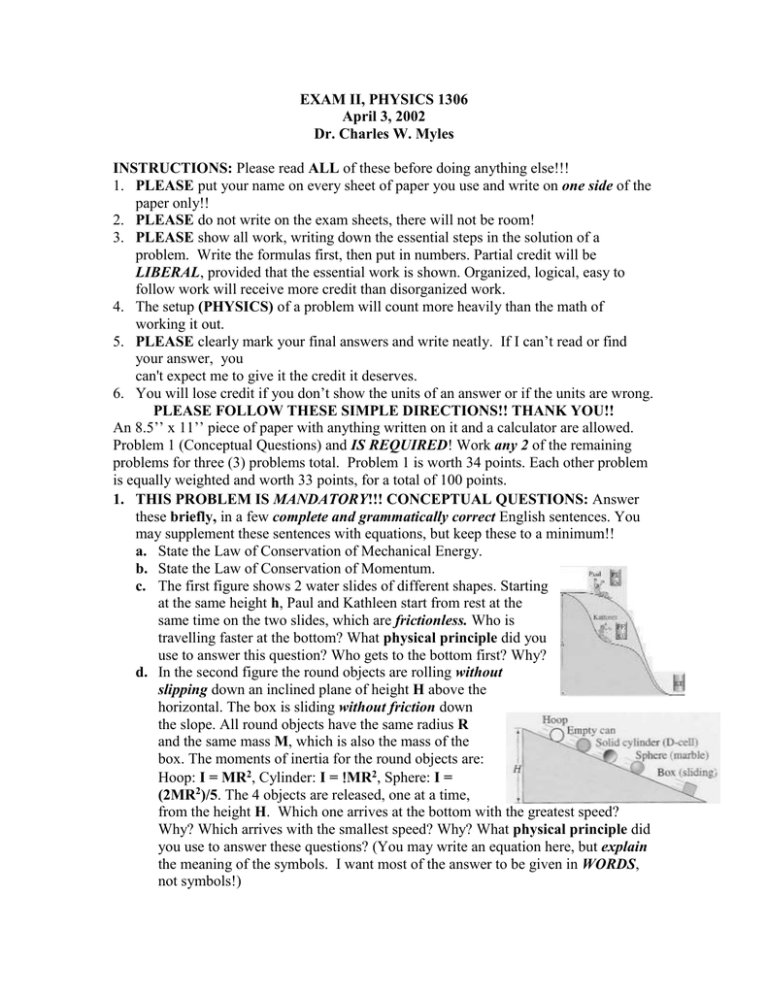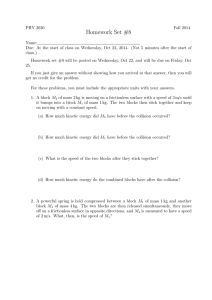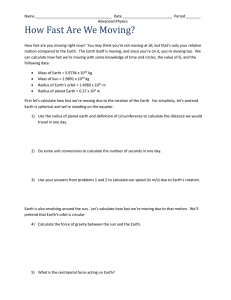EXAM II, PHYSICS 1306 April 3, 2002 Dr. Charles W. Myles INSTRUCTIONS:
advertisement

EXAM II, PHYSICS 1306 April 3, 2002 Dr. Charles W. Myles INSTRUCTIONS: Please read ALL of these before doing anything else!!! 1. PLEASE put your name on every sheet of paper you use and write on one side of the paper only!! 2. PLEASE do not write on the exam sheets, there will not be room! 3. PLEASE show all work, writing down the essential steps in the solution of a problem. Write the formulas first, then put in numbers. Partial credit will be LIBERAL, provided that the essential work is shown. Organized, logical, easy to follow work will receive more credit than disorganized work. 4. The setup (PHYSICS) of a problem will count more heavily than the math of working it out. 5. PLEASE clearly mark your final answers and write neatly. If I can’t read or find your answer, you can't expect me to give it the credit it deserves. 6. You will lose credit if you don’t show the units of an answer or if the units are wrong. PLEASE FOLLOW THESE SIMPLE DIRECTIONS!! THANK YOU!! An 8.5’’ x 11’’ piece of paper with anything written on it and a calculator are allowed. Problem 1 (Conceptual Questions) and IS REQUIRED! Work any 2 of the remaining problems for three (3) problems total. Problem 1 is worth 34 points. Each other problem is equally weighted and worth 33 points, for a total of 100 points. 1. THIS PROBLEM IS MANDATORY!!! CONCEPTUAL QUESTIONS: Answer these briefly, in a few complete and grammatically correct English sentences. You may supplement these sentences with equations, but keep these to a minimum!! a. State the Law of Conservation of Mechanical Energy. b. State the Law of Conservation of Momentum. c. The first figure shows 2 water slides of different shapes. Starting at the same height h, Paul and Kathleen start from rest at the same time on the two slides, which are frictionless. Who is travelling faster at the bottom? What physical principle did you use to answer this question? Who gets to the bottom first? Why? d. In the second figure the round objects are rolling without slipping down an inclined plane of height H above the horizontal. The box is sliding without friction down the slope. All round objects have the same radius R and the same mass M, which is also the mass of the box. The moments of inertia for the round objects are: Hoop: I = MR2, Cylinder: I = MR2, Sphere: I = (2MR2)/5. The 4 objects are released, one at a time, from the height H. Which one arrives at the bottom with the greatest speed? Why? Which arrives with the smallest speed? Why? What physical principle did you use to answer these questions? (You may write an equation here, but explain the meaning of the symbols. I want most of the answer to be given in WORDS, not symbols!) NOTE: WORK ANY TWO (2) OF PROBLEMS 2., 3., 4. or 5.!!!!! 2. See the figure. A planet, mass m = 1 x 1025 kg, is in a circular orbit at constant speed around a star, which is assumed to be a uniform sphere of constant density. The radius of the orbit (measured from the star’s center) is r = 1.5 x 1011 m. The mass of the star is M = 3 x 1030 kg. The gravitational constant is G = 6.67 x 10-11 N m2/kg2. a. The planet goes around the star in a circular orbit, so obviously the planet experiences a centripetal acceleration. Using words (not equations!) tell me what the cause of this centripetal acceleration is. (Hint: See part b!) b. Compute the gravitational force of attraction between the planet and the star. What is the “centripetal force” on the planet? (Hint: Answers to a & b should be consistent! You don’t need to know the speed of the planet to answer this!). c. Compute the centripetal acceleration experienced by the planet. What is the direction of this acceleration? (You don’t need to know the speed of the planet to answer this!). d. What is the speed of the planet in orbit? e. What is the period of the planet’s orbit? 3. The pulley in the figure has mass M = 10 kg and radius R = 0.5 m. It is a uniform solid disk with moment of inertia I = MR2. A massless cord is wrapped around it and a tension force FT is applied. It starts from rest. After FT is applied for 10 s, the angular speed is = 50 rad/s. a. What is the pulley’s angular acceleration? What is the linear (tangential) acceleration of a point on the rim of the pulley? b. What is the net torque acting on the pulley? What physical principle did you use to do this calculation? c. If FT is the only force producing a torque, calculate FT. NOTE: The answers to parts d and e do not depend on the answers to a, b, and c! d. After FT is applied for 10 s, what are the pulley’s kinetic energy and angular momentum? e. After FT is applied for 10 s, what are the linear velocity and radial (centripetal) acceleration of a point on the rim of the pulley? NOTE: WORK ANY TWO (2) OF PROBLEMS 2., 3., 4. or 5.!!!!! 4. See the figure. A railroad engine, mass M = 50,000 kg, traveling at a speed of 20 m/s strikes a car, mass m = 5,000 kg, which is at initially at rest because it is stuck in the crossing (the people in the car have run away from it!). After the collision, the railroad engine and the car STICK TOGETHER and move off down the tracks. Before Collision After Collision a. What were the initial momentum and kinetic energy of the engine? b. What was the momentum of the engine-car combination as they moved away from the collision? What was their speed immediately after the collision? What physical principle did you use to find these? c. What was kinetic energy of the engine-car combination just immediately after the collision? Was kinetic energy conserved? Was momentum conserved? Explain (using brief, complete, grammatically correct English sentences!). d. What impulse was delivered to the car by the engine? If the collision time was t = 2 x 10-2 s, what was the average force exerted by the truck on the car? e. After the collision, the engine-car combination skids until it stops a distance d = 50 m away from the collision point. Assuming that work by the frictional force between the engine-car combination and the track is what causes them to stop, how much work is done by friction in this process? 5. The figure shows a roller coaster car, mass m = 2,500 kg, on a portion of a roller coaster ride. The height difference between points A and B is 30 m. The height difference between points B and C is 25 m. The car starts from rest at point A. Take the zero of gravitational potential energy (y = 0) to be at point B. For parts a. and b. assume that the roller coaster track is frictionless. a. What is the gravitational potential energy of the car at points A, B, and C? b. What is the kinetic energy of the car at point B? What is its speed ? What physical principle did you use to do this calculation? c. What is the kinetic energy of the car at point C? What is its speed there? d. Parts a., b., and c. assume that the track is frictionless. However, the measured speed of the car at point B is found to be vB = 20 m/s. This is less than the speed that you (should have) computed in part b. This means that friction cannot be neglected. In this case, how much work is done by friction when the car moves from point A to point B? What physical principle did you use to compute this work? e. If the total distance traveled from point A to point B is d = 200 m, use the results of part d. to compute the frictional force acting on the car.





